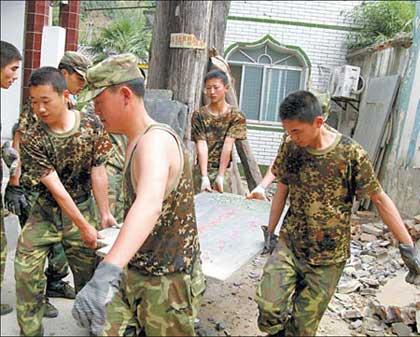Source: Xinhua
05-30-2008 15:32
BEIJING, May 30 -- Captain Wu Hongyu's mission Thursday was to move thousands of historical relics out of the "Forbidden City Deep In The Mountains" - another appellation for the 600-year-old Bao'en Temple, which was devastated by the earthquake on May 12.
 |
| Soldiers carry a stone monument out of Bao'en Temple Thursday, May 29, 2008. (Photo: China Daily) |
Wu was carefully counting removed relics in a tent lying in the open square by the temple.
"We moved more than 3,200 historical relics out of the small hall today," Wu said.
Tianwangdian (Hall of the Heavenly King) is one of Bao'en Temple's six halls.
Located behind the Daxiongbaodian - the "Grand Hall", or "Hall of Mahavira" - Tianwangdian's structure was severely damaged in the disaster.
Wu's team had to act quickly to remove the precious artifacts from the building, which was in danger of collapse.
"Nobody knows if or when the small hall will collapse, because the aftershocks never stopped; they are especially bad between 2 p.m. and 5 p.m. every day," he said, adding he held his breath every time he saw his colleagues rush into the building.
The heaviness of many of the relics made the task more difficult. In addition to nearly 3,000 books and written works, the temple contained more than 200 large, heavy artifacts, such as Buddha josses, stone sculptures and monuments.
The soldiers had to exercise extreme care when handling these items. They couldn't use tools in the removals, because they might damage the rare relics.
On several occasions, Wu had to send four or more soldiers to carry a single monument. However, he was happy the Grand Hall survived the quake.
The "Forbidden City Deep In The Mountains'" moniker came from the fact that the Ming Dynasty temple, completed in 1440, was built as a small-scale replica of Beijing's Forbidden City.
